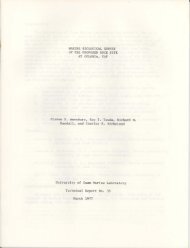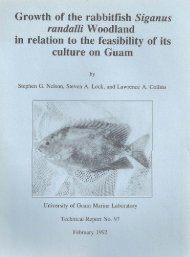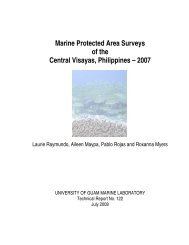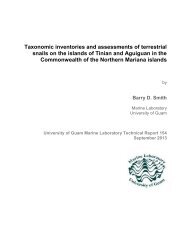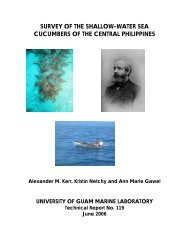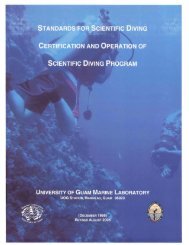Phylogeny of Holothuroidea (Echinodermata) inferred from ...
Phylogeny of Holothuroidea (Echinodermata) inferred from ...
Phylogeny of Holothuroidea (Echinodermata) inferred from ...
Create successful ePaper yourself
Turn your PDF publications into a flip-book with our unique Google optimized e-Paper software.
PHYLOGENY OF SEA CUCUMBERS 65<br />
Figure 1. Phylogenetic hypotheses <strong>of</strong> holothuroid relationships. A, Pawson & Fell’s (1965) Linnaean classification<br />
rendered as a phylogeny. B, Ludwig (1891). C, MacBride (1906). D, Semper (1868). E, Haude (1992). F, Interpretation<br />
by Smith (1997) <strong>of</strong> data <strong>from</strong> Littlewood et al. (1997). Taxon designations are <strong>from</strong> Pawson & Fell (1965) and exclude<br />
members <strong>of</strong> three families (Synallactidae, Eupyrgidae, Gephyrothuriidae) whose ordinal assignments differ between<br />
authors. Asterisks indicate alternative possible positions for Molpadiida.<br />
7.4). However, it also displays two undoubted au- assignment for Palaeocucumaria and the hypothetical<br />
tapomorphies <strong>of</strong> <strong>Holothuroidea</strong>, a calcareous ring and ancestor is given in the section on characters.<br />
an antero-posteriorly elongated body.<br />
Finally, we rooted trees on the longest branch (‘longbranch<br />
Fossil taxa <strong>of</strong>ten lack s<strong>of</strong>t-tissue preservation so that<br />
rooting’) suggested by the fossil histories <strong>of</strong> the<br />
characters must be coded as missing. Characters <strong>from</strong> groups. The oldest undoubted holothuroid ossicles are<br />
Palaeocucumaria are no exception: internal features, assignable to dendrochirotaceans (first recorded <strong>from</strong><br />
other than the calcareous ring and a gut trace visible Upper Silurian), Elasipodida (Middle Devonian) and<br />
by radiography (Lehmann, 1958), are not preserved Apodida (Middle Devonian) (Gilliland, 1993). Hence,<br />
and diagenesis obscures the body-wall ossicles (but see we predicted that the longest branch, the one with<br />
interpretation by Seilacher, 1961). Hence, in addition the most unambiguous changes, would lie somewhere<br />
to rooting the holothuroid tree with Palaeocucumaria, between these groups and that rooting on this branch<br />
we used a hypothetical ancestor (‘ancestor rooting’) will create a topology in which the placements <strong>of</strong> these<br />
based on primitive states <strong>inferred</strong> <strong>from</strong> Pa- groups are concordant with those produced by the<br />
laeocucumaria, Ophiocistioidea, Palaeozoic Echinoidea other rooting procedures.<br />
and extant Echinoidea. Echinoids are used in this<br />
role as they are recognized as the sister group to<br />
ophiocistioids+holothuroids (Littlewood et al., 1997)<br />
PHYLOGENETIC ANALYSES<br />
and living echinoids permit coding <strong>of</strong> some s<strong>of</strong>t- Maximum-parsimony analyses <strong>of</strong> the data were performed<br />
tissue features. Justification <strong>of</strong> each character-state<br />
on PAUP∗ 4.0b 2a (Sw<strong>of</strong>ford, 1998) with the





